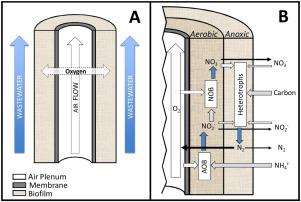Journal of Environmental Chemical Engineering ( IF 7.4 ) Pub Date : 2020-10-20 , DOI: 10.1016/j.jece.2020.104644 Nick Landes , Arifur Rahman , Audra Morse , W. Andrew Jackson

|
A membrane-aerated biofilm reactor (MABR) was designed for the treatment of a source-separated urine wastewater formulated to mimic conditions on an early planetary space habitation. Literature suggested that a MABR would not work effectively for N removal for this wastewater since it is nitrogen dominant (TOC:N < 1). The MABR confirmed this hypothesis by recording average nitrification and denitrification efficiencies as high as ∼65% and ∼35%, respectively. Nonetheless, the simultaneous nitrification and denitrification (SND) performance was unexpectedly high when compared to the reactor’s low liquid velocities (0.004 cm/s) and it’s relatively high bulk dissolved oxygen levels (> 2 mg/L). Dissolved organic carbon (DOC) removal and nitrification rates were reported as high as 0.33 ± 0.12 g-C/m2-d and 0.32 ± 0.02 g-N/m2-d, respectively. Additionally, the MABR achieved total nitrogen (TN) removal efficiency of 36.5%. Additionally, the operational parameters of hydraulic retention time (HRT), intramembrane partial oxygen pressure (pO2), recycle ratio and liquid velocity linked with bulk dissolved oxygen concentration were evaluated. It was observed that TN removal was significantly impacted by the variation of those parameters, but DOC removal efficiency and nitrification rate did not change significantly. This study helps to establish the efficacy of MABR systems for the treatment of nitrogen dominant, space-based wastewater.
中文翻译:

实验室规模的膜曝气生物膜反应器通过同时硝化-反硝化处理氮占优势的天基废水的性能
膜曝气生物膜反应器(MABR)设计用于处理分离源尿液,该尿液经配制以模仿早期行星空间栖息地的条件。文献表明,MABR不能有效去除这种废水中的N,因为它是氮的主要成分(TOC:N <1)。MABR通过记录分别高达〜65%和〜35%的平均硝化效率和反硝化效率,证实了这一假设。但是,与反应器的低液体流速(0.004 cm / s)和较高的整体溶解氧水平(> 2 mg / L)相比,同时硝化和反硝化(SND)性能出乎意料地高。据报道溶解有机碳(DOC)的去除和硝化速率高达0.33±0.12 gC / m 2-d和0.32±0.02 gN / m 2 -d。此外,MABR的总氮(TN)去除效率达到了36.5%。此外,还评估了水力停留时间(HRT),膜内分氧压(pO2),循环比和液体速度与整体溶解氧浓度相关的操作参数。可以看出,TN的去除受到这些参数的变化的显着影响,但是DOC去除效率和硝化率没有明显变化。这项研究有助于建立MABR系统用于处理氮占优势的空间废水的功效。











































 京公网安备 11010802027423号
京公网安备 11010802027423号